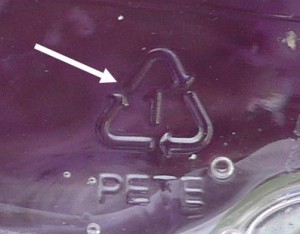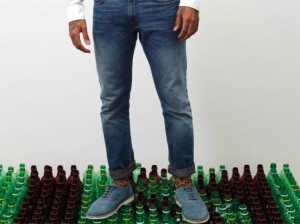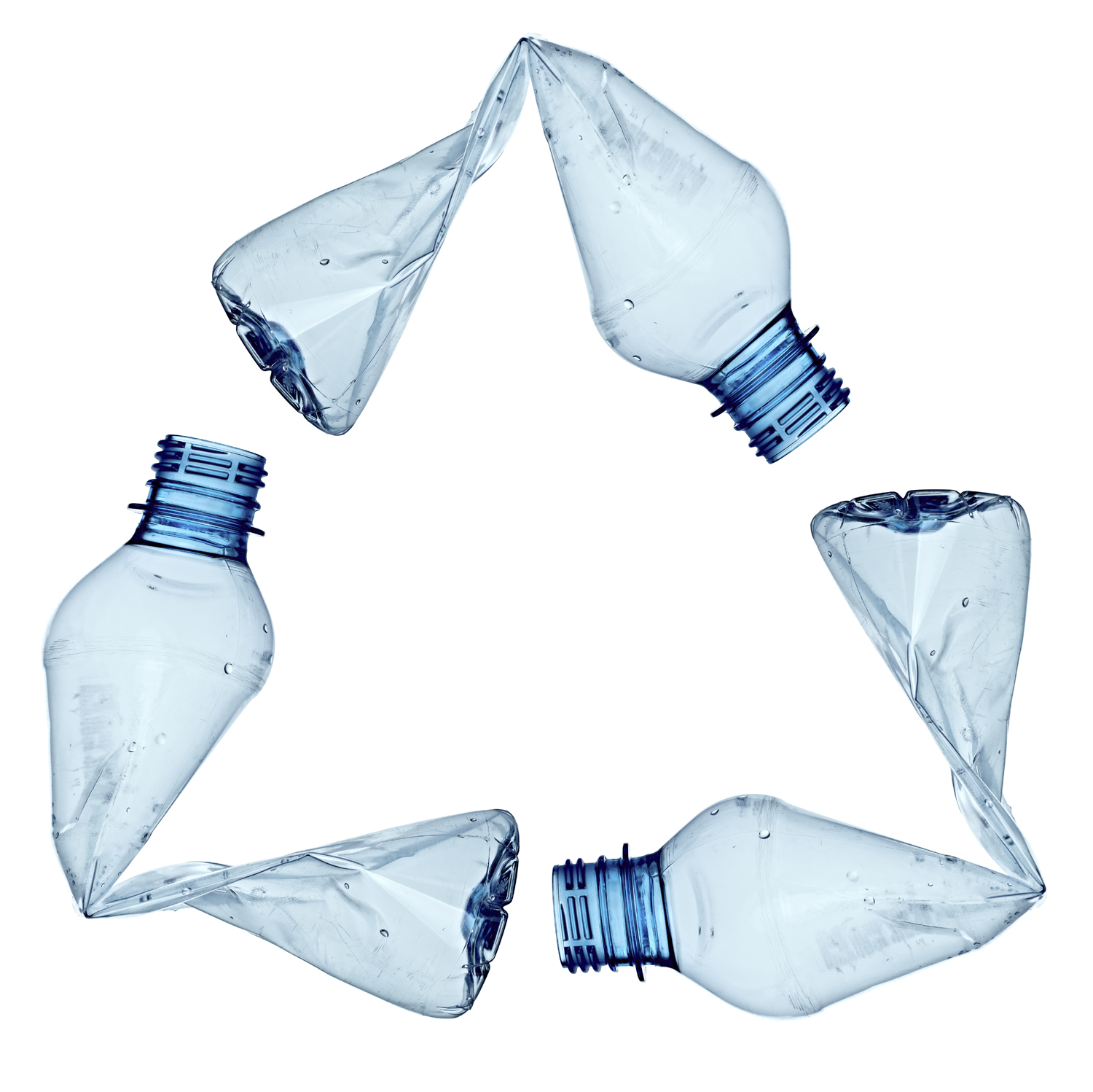Have you ever wondered what does the following sign on a plastic bottle mean?

It is a recycling symbol or a PIC (plastic Identification Code), a triangle with a number from 1 to 7 inside. Each number represents a different type of plastic, and some numbers are easier to recycle than others.The PIC was introduced by the Society of the Plastics Industry, Inc., to provide a uniform system for the identification of various polymer types and to help recycling companies separate various plastics for reprocessing.
There are seven groups of plastic polymers and hence the 7 types of PIC are as follows:

#1 – PETE or PET (Polyethylene Terephthalate)
PET is clear, tough, and has good gas and moisture barrier properties. Plastic #1 used to make soda bottles, water bottles, cooking oil bottles and medicine containers. Though it is considered to be safe, but this plastic can allow bacteria and flavour to accumulate. These are also used in plastic soft drink, water, sports drink, beer, mouthwash, ketchup and salad dressing bottles, peanut butter, pickle, jelly and jam jars. PETE is recycled into tote bags, furniture, carpet, panelling, fibre, and polar fleece.
It is advised to not to leave PETE bottles in car. Also the container should not be filled with hot liquids or exposed to high heat. The reason behind this is that it degrades with use and the wrinkled surfaces can host germs. They contain trace amount of Bisphenol A (BPA), which has been linked to breast and uterine cancer, an increased risk of miscarriage, and decreased testosterone levels.
Fabrics using PET !
One innovative use of this recycled PET that has recently started to become popular is to create fabrics to be used in the clothing industry. The fabrics are created by spinning the PET flakes into thread and yarn. The recycled PET thread or yarn can be used either alone or together with other fibres to create a very wide variety of fabrics. As a result of the public’s growing awareness of environmental issues, these types of fabrics have become very popular. Numerous clothing manufacturers have capitalized on this trend.

Plastic #2 – HDPE (High Density Polyethylene)
It is the most recycled plastic. This plastic is considered to be safe and has low risk of leaching. HDPE is used for packaging chemicals both household and industrial such as detergents and bleach. It is found mostly in milk jugs, household cleaner containers, laundry/dish detergent containers, juice bottles, shampoo bottles, grocery bags, various toys, cereal box liners, motor oil bottles, yoghurt tubs, and butter tubs. This plastic can be recycled into pens, recycling containers, picnic tables, lumber, benches, fencing, and detergent bottles, to name a few.
Plastic #3 – V or PVC (Vinyl or Poly vinyl chloride):
This plastic is used in bottles manufacturing and packaging sheet industries, and is also widely used in the construction market for such applications as pipes and fittings, siding, carpet backing and windows, shampoo bottles, clear food packaging, cooking oil bottles, pipes, shower curtains, clear medical tubing, vinyl dashboards and seat covers. PVC is recycled into panelling, flooring, speed bumps, decks, and roadway gutters. But, at the same time, these contain numerous toxic chemicals called phthalates (“plasticizers”). These phthalates are linked to numerous health issues ranging from developmental problems to miscarriages. They also contain DEHA, which is responsible for cancer due to long-term exposure, loss of bone mass and liver problems. Hence, use of this plastic should be done carefully. One should not cook with or burn this plastic.
Plastic #4 – LDPE (Low Density Polyethylene)
This plastic is considered to be safe for recycling purposes. Polyethylene is most found in squeezable bottles, shopping bags, clothing, carpet, frozen food, bread bags, and some food wraps. This plastic is recycled into compost bins, panelling, trash can liners and cans, floor tiles, and shipping envelopes.
Plastic #5 – PP (Polypropylene)
Plastic #5 is also among the safer plastics one can recycle. PP is used in packaging and manufacturing large moulded parts for automotive products. Polypropylene is often chosen for containers that can accept hot liquid. It is typically found in yoghurt containers, ketchup bottles, syrup bottles, Tupperware, yoghurt tubs, plastic caps of soda bottles and medicine bottles. Polypropylene is recycled into brooms, auto battery cases, bins, pallets, signal lights, ice scrapers, and bicycle racks.
Plastic #6 – PS (Polystyrene)
Polystyrene is a versatile plastic that can be rigid or foamed. Most polystyrene products are currently not recycled due to the lack of incentive to invest in the logistical systems required. As a result, manufacturers cannot obtain sufficient scrap. But, even this type of plastic poses a health risk, leaching potentially toxic chemicals, especially when heated. Most recycling programs won’t accept it. Plastic #6 is found in compact disc cases, egg cartons, meat trays, plastic cups, disposable cutlery and cups (clear and coloured), coffee cups, packing peanuts. It is recycled into egg cartons, vents, foam packing, and insulation.
Plastic #7 – Other (Miscellaneous)
Use of this code indicates that the plastic is made with a resin other than the six listed above, or is made of a mixture of more than one resin and used in a multi-layer combination. Plastic #7 is found in sunglasses, iPod cases, computer cases, and bullet-proof materials. It is recycled into plastic lumber and other custom-made products. There is very little recycling potential for most # 7 plastics at this time.These plastics should be avoided due to the presence of hormone disruptor like BPA, which has been linked to infertility, hyperactivity, reproductive problems, and other health issues.
Which Recycling Numbers should be avoided?
While Number 1 is considered safe, one should avoid recycling numbers 3, 6, and 7. Plastics with symbols 2, 4, and 5 are considered to be safest. These are the plastics to look for in terms of human and animal consumption.
Cleanliness is essential
Care should be taken that the plastic is clean. Even a tiny speck of waste can contaminate an entire bale, containing thousands of tonnes of collected plastics. This can cause the recyclable items to go to a landfill instead of being recycled.
A very important point that one should note is that soda bottles and caps should be separated before recycling. The reason behind this is that usually bottles are plastic# 1 and caps are plastic # 5 and we know that different types of plastic do not recycle together.
Road made of Plastic! – India shines
K. Ahmed Khan, an Indian scientist and businessman along with Kerala Highway Research Institute achieved success in using plastic for road construction. He came up with the brainwave of recycling plastic and mixing it with bitumen to lay roads. Thanks to his spirit, almost 1,000 km of road has been laid. Every day in India, 1,23,000 tonnes of waste is produced, out of which about 2000 tonnes is plastic. If we can use even a small percentage of this plastic in such a manner, then plastic waste problem management can surely be solved. His concept of the use of plastic in such a manner has even attracted attention from the Burmese government and entities in Italy.


Leave a Reply